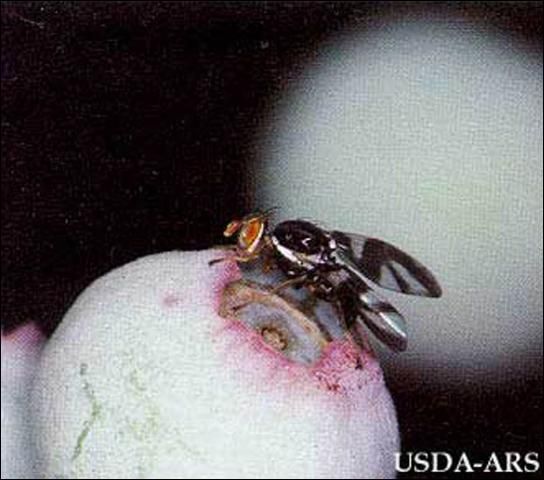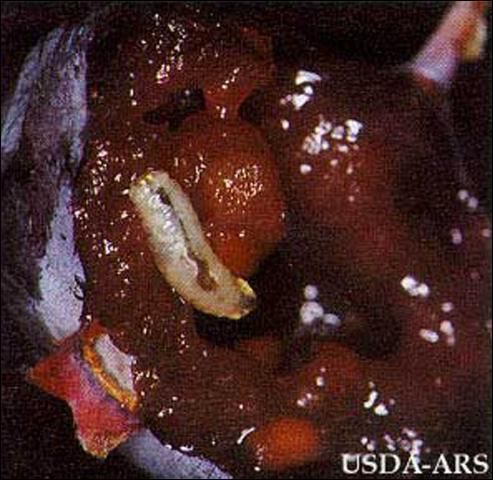The Featured Creatures collection provides in-depth profiles of insects, nematodes, arachnids and other organisms relevant to Florida. These profiles are intended for the use of interested laypersons with some knowledge of biology as well as academic audiences.
Introduction
The blueberry maggot, Rhagoletis mendax Curran, is an important pest of commercially grown blueberries (Marucci 1966). Since first reported in 1914 in Maine and New Hampshire, the blueberry maggot has damaged crops primarily in the northeastern and north central United States and Canada (Milholland and Meyer 1984). The blueberry maggot was discovered in 1991 at high infestation levels in several commercial plantings in northeast Georgia (Stephens and Habersham Cos.) and in 1992 in extreme southern Alabama (Escambia Co.) (Payne et al. 1993). Very low levels of infested fruit were detected also in southeastern Georgia Counties (Bacon and Clinch) in 1992. Where blueberry production continues to expand in the southeastern United States, this pest is likely to become more apparent.
Distribution
Blueberry maggot is found throughout the eastern United States including AL, CT, DL, FL, GA, ME, MD, MA, MI, NH, NJ, NY, NC, PA, RI, TN, VA, and WV. In Canada, it is known from New Brunswick, Nova Scotia, Ontario, and Prince Edward Island.
Taxonomy
Bush (1966) recognized a Rhagoletis pomonella species group and delimited four very similar species based on morphology, host plants, distribution, phenology and crossbreeding experiments: Rhagoletis mendax, Rhagoletis pomonella (Walsh) (apple maggot), Rhagoletis cornivora Bush (dogwood berry maggot) and Rhagoletis zephyria Snow (snowberry maggot). Genetic studies employing electrophoretic analysis of protein variation have confirmed these species (Berlocher and Bush 1982; Feder et al. 1989).
Description
Adult
body length 3 to 4 mm (~1/8 – 3/16 in); mostly black, thorax with conspicuous white spot at tip (scutellum) and a white stripe along each side; abdomen with fine white bands separating segments; wing length 3 to 4 mm (~1/8 – 3/16 in), with conspicuous black bands. Accurate identification of Rhagoletis mendax adults depends on careful measurement of wing band ratios, ovipositor length and other genitalia features. Morphological separation from other pomonella group species may not be possible in many cases (Bush 1966).

Credit: J. A. Payne, USDA-ARS
Larva
Creamy white, legless maggot attaining 5 to 6 mm (~3/16 – ¼ in) in length; anterior end tapered, with a pair of fine, black mouthhooks; posterior end truncate, tubercular, with a pair of fine, brown spiracles lying flat on surface. There are no known morphological differences to separate larvae of Rhagoletis mendax from those of Rhagoletis pomonella and Ragoletis cornivora.

Credit: J. A. Payne, USDA-ARS
Host Plants
Host include Vaccinium angustifolium Aiton, lowbush blueberry; Vaccinium myrtilloides Michaux (=Vaccinium canadense Rich.), sourtop blueberry; Vaccinium corymbosum L., highbush blueberry; Vaccinium pallidum Aiton, hillside blueberry; Vaccinium stamineum L., deerberry; Vaccinium vitis-idaea L., lingonberry; Gaylussacia baccata (Wang.) K. Koch, black huckleberry; Gaylussacia frondosa (L.) Torr. & Gray, dangleberry; and Gaylussacia dumosa (Andrz.) Torr & Gray, dwarf huckleberry.
It should be noted that Rhagoletis fruit flies in the southeast also infest sparkleberry, Vaccinium arboreum Marsh., which fruits during August to November. Currently these flies also are identified as Rhagoletis Mendax, but ecological, phenological (J.A. Payne, unpublished data) and genetic differences (S.H. Berlocher, personal communication) suggest that they represent a separate, undescribed species of Rhagoletis.
Life History
Rhagoletis mendax overwinter as pupae in the soil. In Florida and Georgia, adult flies appear about late May and persist until late July during the time when their native host plant, deerberry, is fruiting. Since this period overlaps with commercial blueberry production, commercial blueberries are also at risk of infestation. Adults have a pre-reproductive period of one to two weeks, during which they forage for nutrients on various plants. Upon attaining sexual maturity, flies mate and females begin ovipositing. Normally, a single egg is laid into a berry. Females produce 25 to 100 eggs over a period of 15 to 30 days. Eggs incubate for three to 10 days before hatching to produce first instar maggots. Larvae feed in the fruit pulp for a period of 17 to 22 days while passing through two additional molts. The pulp eventually may be completely consumed. After feeding, the larvae drop to the ground, enter the soil, and pupate several centimeters (~ 1 in) below the surface. In northern states, most pupae overwinter only until the following season, but some pupae may remain in the soil for up to five years before metamorphosing to the adult stage. The phenology of southern populations is poorly known.
Survey and Control
Potential blueberry maggot infestations can be monitored by trapping adult flies on yellow sticky boards. Boards are baited with ammonium carbonate and placed at a density of two to four traps per acre (McVay et al. 1993). Traps should be placed near fruit in a shady part of the bush between knee and waist level. A treatment threshold of either three adults per trap per week or five adults per field normally gives adequate time for chemical control if trapping begins before first adults emerge (Meyer et al. 1989). Note that occurrence of adults in traps only indicates the possibility of egg-laying and larval infestation. If adults have been trapped, we recommend that several hundred ripening fruit be cut and checked for the presence of maggots. Only in orchards that were damaged by blueberry maggots the previous year should spraying begin as soon as adults are caught and positively identified. A short-residual insecticide should be used during harvest. For specific chemical recommendations, consult the Insect Management Guide for Blueberries.
Selected References
Berlocher, S.H. and G.L. Bush. 1982. An electrophoretic analysis of Rhagoletis (Diptera: Tephritidae) phylogeny. Systematic Zoology 31:136–155.
Bush, G.L. 1966. The taxonomy, cytology, and evolution of the genus Rhagoletis in North America (Diptera, Tephritidae). Bulletin Museum Comparative Zoology. 134:431–562.
Feder, J.F., C.A. Chilcote, and G.L. Bush. 1989. Are the apple maggot, Rhagoletis pomonella, and blueberry maggot, R. mendax, distinct species? Implications for sympatric speciation. Entomologia Experimentalis et Applicata 51:113–123.
McVay, J., D. Horton, J. Payne, and A. Amis. 1993. Practical IPM concerns for blueberry maggots and other pests. pp.39–42. In Proc., 6th Biennial southeast Blueberry Conference and Trade Show, University Georgia Cooperative Extension Service.
Marucci, P. 1966. Insects and their control. pp. 199–235. In P. Eck and N.F. Childers (eds.) Blueberry Culture, Rutgers University Press, New Brunswick, N.J.
Meyer, J., J.A. Payne and D.L. Horton. 1989. Blueberry insects. pp. 42-55. In D. Horton, P. Bertrand, and G.Krewer (eds.) Small Fruit Pest Management and Culture. Cooperative Extension Service, University Georgia College Agricutlure Bulletin 1022.
Milholland, R.D. and J.R. Meyer. 1984. Diseases and arthropod pests of blueberries. North Carolina Agriculture Research Service, North Carolina State University, Raleigh. Bulletin 468. 33 pp.
Payne, J.A., A.A. Amis, R.J. Beshear, R. J. Gagne, D.L. Horton, and P.M. Lyrene. 1993. "New" rabbiteye blueberry insects: maggots, midges, thrips, and root weevils. pp. 37-38. In Proc., 6th Biennial Southeast Blueberry Conference and Trade Show, University Georgia Cooperative Extension Service.